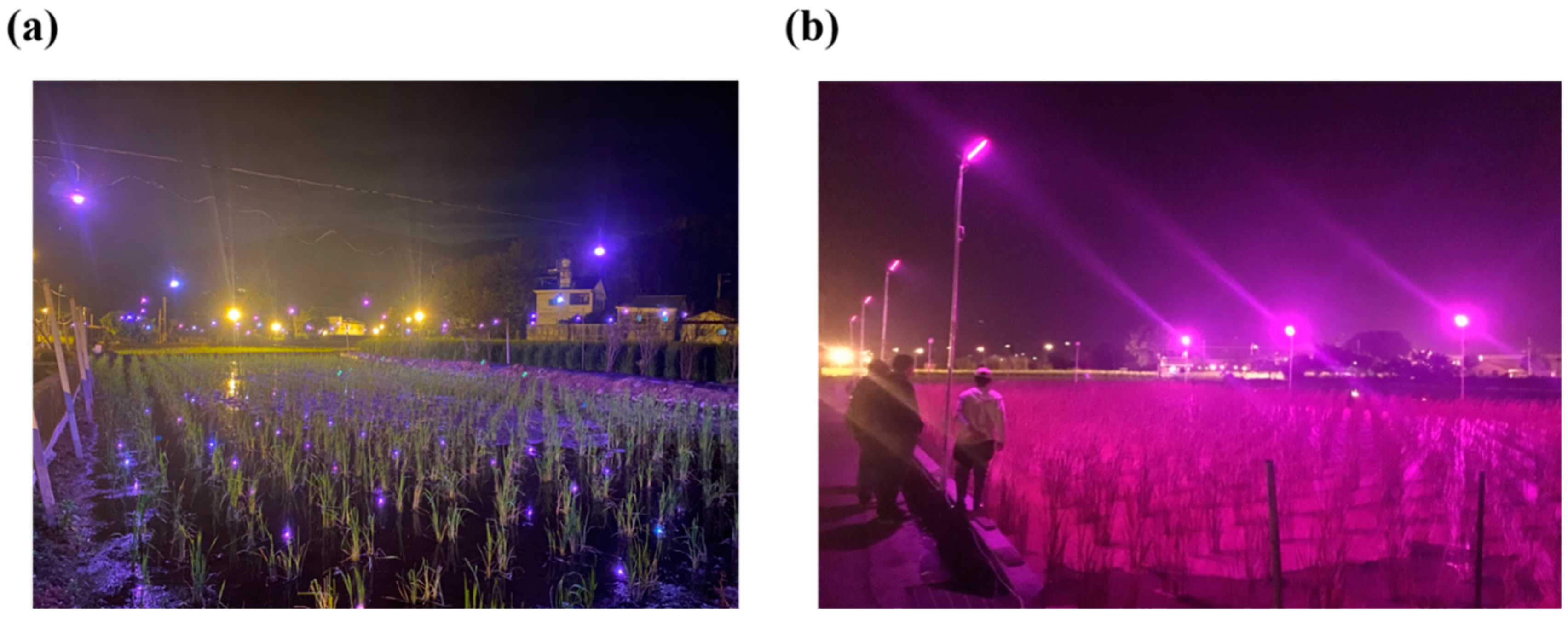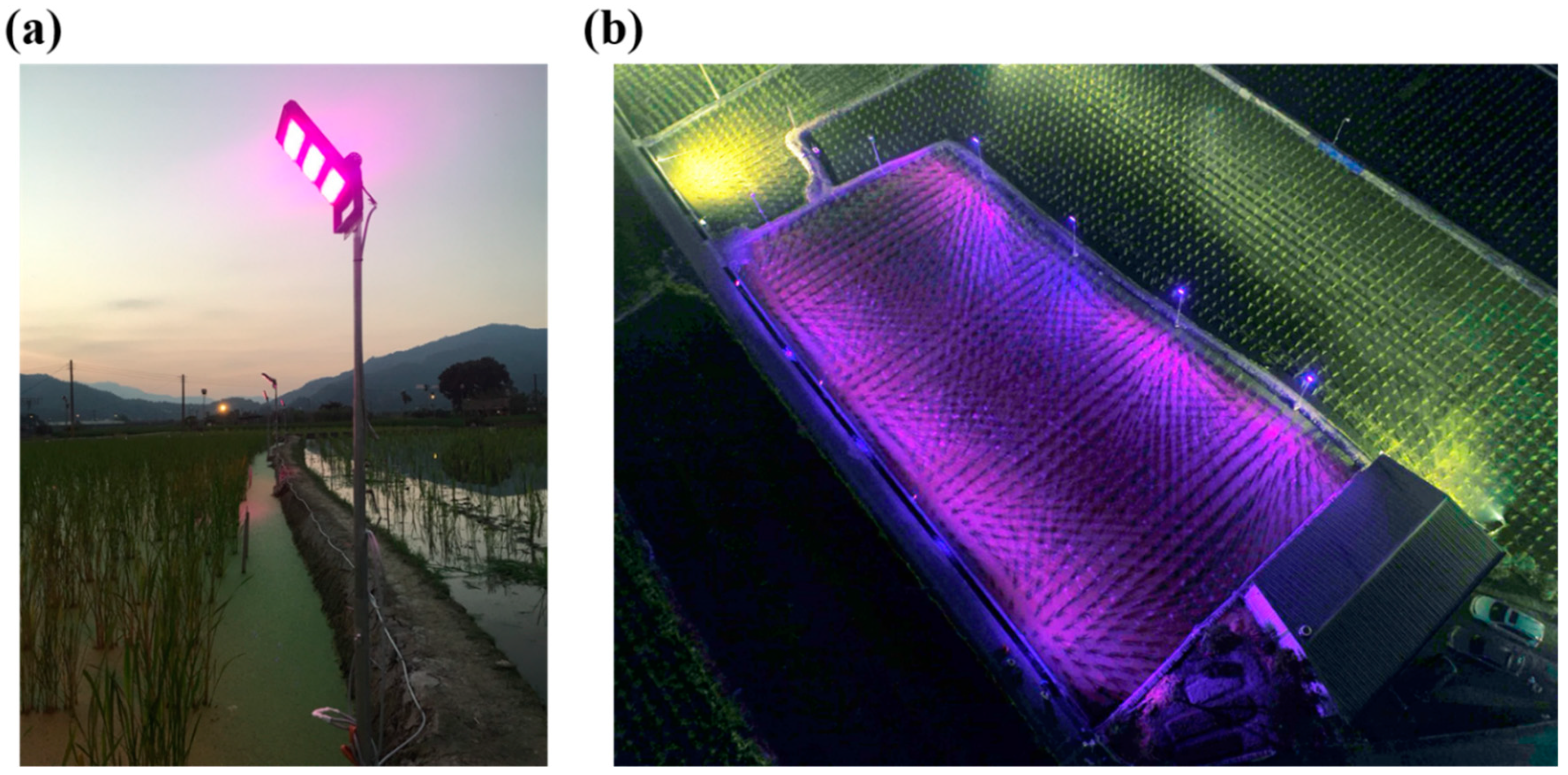Optimized LED-Integrated Agricultural Facilities for Adjusting the Growth of Water Bamboo (Zizania latifolia)
Abstract
:1. Introduction
2. Experimental
3. Results and Discussion
4. Conclusions
Author Contributions
Funding
Conflicts of Interest
References
- Huang, J.-H. Occurrence and management of basal stalk rot of water bamboo in Taiwan. In Proceedings of the 2018 International Symposium on Proactive Technologies for Enhancement of Integrated Pest Management of Key Crops, Taichung, Taiwan, 3–5 April 2018. [Google Scholar]
- Huang, J.-H. The use of night lighting system to prevent the occurrence of stunting of water bamboo. Taiwan Agric. Res. 2018, 67, 309–317. [Google Scholar] [CrossRef]
- Huang, J.-H. The occurrence and prevention of water bamboo stunting. Taiwan Agric. Res. 2016, 65, 278–285. [Google Scholar] [CrossRef]
- Gilewski, M. The role of light in the plants world. Photonics Lett. Pol. 2019, 11, 115. [Google Scholar] [CrossRef]
- Supronowicz, R.; Fryc, I. Urban park lighting as a source of botanical light pollution. Photonics Lett. Pol. 2019, 11, 90. [Google Scholar] [CrossRef]
- Clark, J.B.; Lister, G.R. Photosynthetic Action Spectra of Trees: I. Comparative Photosynthetic Action Spectra of One Deciduous and Four Coniferous Tree Species as Related to Photorespiration and Pigment Compements. Plant Physiol. 1975, 55, 401–406. [Google Scholar] [CrossRef] [PubMed] [Green Version]
- Gayral, B. LEDS for lighting: Basic physics and prospects for energy savings. C. R. Phys. 2017, 18, 453–461. [Google Scholar] [CrossRef]
- Massa, G.D.; Kim, H.H.; Wheeler, R.M.; Mitchell, G.A. Plant productivity in response to LED lighting. Hortscience 2008, 43, 1951–1956. [Google Scholar] [CrossRef]
- Agarwal, A.; Gupta, S.D. Impact of light-emitting diodes (LEDs) and its potential on plant growth and development in controlled-environment plant production system. Curr. Biotechnol. 2016, 5, 28–43. [Google Scholar] [CrossRef]
- Nelson, J.A.; Bugbee, B. Economic analysis of greenhouse lighting: Light emitting diodes vs. high intensity discharge fixtures. PLoS ONE 2014, 9, e99010. [Google Scholar] [CrossRef] [PubMed] [Green Version]
- Cui, H.; Meng, F.; Li, Y.; Wang, Y.; Duan, W. Effects of artificial light source and light quality on the growth of two species of microalgae. Sci. Discov. 2016, 4, 129–136. [Google Scholar] [CrossRef] [Green Version]
- Tosti, G.; Benincasa, P.; Cortona, R.; Falcinelli, B.; Farneselli, M.; Guiducci, M.; Onofri, A.; Pannacci, E.; Tei, F.; Giulietti, M. Growing lettuce under multispectral light-emitting diodes lamps with adjustable light intensity. Ital. J. Agron. 2018, 13, 883. [Google Scholar] [CrossRef] [Green Version]
- D’Souza, C.; Yuk, H.-G.; Khoo, G.H.; Zhou, W. Application of light-emitting diodes in food production, postharvest preservation, and microbiological food safety. Compr. Rev. Food Sci. Food Saf. 2015, 14, 719–740. [Google Scholar] [CrossRef]
- Vaštakaite, V.; Viršile, A.; Brazaityte, A.; Samuoliene, G.; Jankauskiene, J.; Novičkovas, A.; Duchovskis, P. Pulsed light-emitting diodes for a higher phytochemical level in microgreens. J. Agric. Food Chem. 2017, 65, 6529–6534. [Google Scholar] [CrossRef] [PubMed]
- Gómez, C.; Izzo, L.G. Increasing efficiency of crop production with LEDs. AIMS Agric. Food 2018, 3, 135–153. [Google Scholar] [CrossRef]
- Gupta, S.D. Light Emitting Diodes for Agriculture: Smart Lighting; Springer: Berlin/Heidelberg, Germany, 2017. [Google Scholar]
- Hasan, M.M.; Bashir, T.; Ghosh, R.; Lee, S.K.; Bae, H. An overview of LEDs’ effects on the production of bioactive compounds and crop quality. Molecules 2017, 22, 1420. [Google Scholar] [CrossRef] [PubMed] [Green Version]
- Rehman, M.; Ullah, S.; Bao, Y.; Wang, B.; Peng, D.; Liu, L. Light-emitting diodes: Whether an efficient source of light for indoor plants? Environ. Sci. Pollut. Res. 2017, 24, 24743–24752. [Google Scholar] [CrossRef] [PubMed]
- Li, X.; Lu, W.; Hu, G.; Wang, X.C.; Zhang, Y.; Sun, G.X.; Fang, Z. Effects of light-emitting diode supplementary lighting on the winter growth of greenhouse plants in the Yangtze River Delta of China. Bot. Stud. 2016, 57, 2. [Google Scholar] [CrossRef] [PubMed] [Green Version]








| Lasting Time | Power | Electricity Fee | Price (US dollar) | |
|---|---|---|---|---|
| HPS lamp | 2–3 years | 400 W | 1 | 60 |
| LED lamp | 10 years | 60 W | 1/10 | 80 |
© 2020 by the authors. Licensee MDPI, Basel, Switzerland. This article is an open access article distributed under the terms and conditions of the Creative Commons Attribution (CC BY) license (http://creativecommons.org/licenses/by/4.0/).
Share and Cite
Hsiao, V.K.S.; Cheng, T.-Y.; Chen, C.-F.; Shiu, H.; Yu, Y.-J.; Tsai, C.-F.; Lai, P.-C.; Tsai, M.-C.; Yang, C.-C.; Chien, H.-Y.; et al. Optimized LED-Integrated Agricultural Facilities for Adjusting the Growth of Water Bamboo (Zizania latifolia). Appl. Sci. 2020, 10, 1330. https://doi.org/10.3390/app10041330
Hsiao VKS, Cheng T-Y, Chen C-F, Shiu H, Yu Y-J, Tsai C-F, Lai P-C, Tsai M-C, Yang C-C, Chien H-Y, et al. Optimized LED-Integrated Agricultural Facilities for Adjusting the Growth of Water Bamboo (Zizania latifolia). Applied Sciences. 2020; 10(4):1330. https://doi.org/10.3390/app10041330
Chicago/Turabian StyleHsiao, Vincent K. S., Teng-Yun Cheng, Chih-Feng Chen, Hao Shiu, Yong-Jin Yu, Chun-Fu Tsai, Pin-Chen Lai, Min-Chia Tsai, Chih-Chi Yang, Hung-Yu Chien, and et al. 2020. "Optimized LED-Integrated Agricultural Facilities for Adjusting the Growth of Water Bamboo (Zizania latifolia)" Applied Sciences 10, no. 4: 1330. https://doi.org/10.3390/app10041330
APA StyleHsiao, V. K. S., Cheng, T.-Y., Chen, C.-F., Shiu, H., Yu, Y.-J., Tsai, C.-F., Lai, P.-C., Tsai, M.-C., Yang, C.-C., Chien, H.-Y., Chen, K.-F., & Tsai, Y.-P. (2020). Optimized LED-Integrated Agricultural Facilities for Adjusting the Growth of Water Bamboo (Zizania latifolia). Applied Sciences, 10(4), 1330. https://doi.org/10.3390/app10041330







